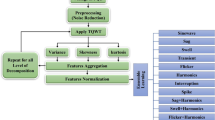Abstract
In this paper we present a novel noisy signal identification method applied in ensemble methods for destructive components classification. Typically two main signal properties like variability and predictability are described by the same second order statistic characteristic. In our approach we postulate to separate measure of the signal internal dependencies and their variability. The validity of the approach is confirmed by the experiment with energy load data.
Access this chapter
Tax calculation will be finalised at checkout
Purchases are for personal use only
Preview
Unable to display preview. Download preview PDF.
Similar content being viewed by others
References
Breiman, L.: Bagging predictors. Machine Learning 24, 123–140 (1996)
Bishop, C.M.: Neural networks for pattern recognition. Oxford Univ. Press, Oxford (1996)
Cardoso, J.F.: High-order contrasts for independent component analysis. Neural Computation 11(1), 157–192 (1999)
Cichocki, A., Amari, S.: Adaptive Blind Signal and Image Processing. John Wiley, Chichester (2002)
Goransson, B.: Direction finding in the presence of spatially correlated noise fields. In: Proc. European Signal Processing Conf. (1994)
Hurst, H.E.: Long term storage capacity of reservoirs. Trans. Am. Soc. Civil Engineers 116, 770–808 (1951)
Hyvarinen, A., Karhunen, J., Oja, E.: Independent Component Analysis. John Wiley, Chichester (2001)
Jaynes, E.T.: Probability Theory: The Logic of Science. Cambridge University Press, Cambridge (2003)
Lee, D.D., Seung, H.S.: Learning of the parts of objects by non-negative matrix factorization. Nature 401 (1999)
Li, Y., Cichocki, A., Amari, S.: Sparse component analysis for blind source separation with less sensors than sources. In: Fourth Int. Symp. on ICA and Blind Signal Separation, Nara, Japan, pp. 89–94 (2003)
Lindley, D.V.: The probability approach to the treatment of uncertainty in artificial intelligence and expert systems. Statistical Science 2, 17–24 (1987)
MacDonough, R.N., Whalen, A.D.: Detection of signals in noise, 2nd edn. Academic Press, San Diego (1995)
Mandelbrot, B.: Multifractals and 1/f noise. Springer, Heidelberg (1997)
Peters, E.: Fractal market analysis. John Wiley and Son, Chichester (1996)
Samorodnitskij, G., Taqqu, M.S.: Stable non-Gaussian random processes: stochastic models with infinitive variance. Chapman and Hall, New York (1994)
Stone, J.V.: Blind Source Separation Using Temporal Predictability. Neural Computation 13(7), 1559–1574 (2001)
Szupiluk, R., Wojewnik, P., Zabkowski, T.: Model Improvement by the Statistical Decomposition. In: Rutkowski, L., Siekmann, J.H., Tadeusiewicz, R., Zadeh, L.A. (eds.) ICAISC 2004. LNCS (LNAI), vol. 3070, pp. 1199–1204. Springer, Heidelberg (2004)
Szupiluk, R., Wojewnik, P., Zabkowski, T.: Prediction Improvement via Smooth Component Analysis and Neural Network Mixing. In: Kollias, S.D., Stafylopatis, A., Duch, W., Oja, E. (eds.) ICANN 2006. LNCS, vol. 4132, pp. 133–140. Springer, Heidelberg (2006)
Therrien, C.W.: Discrete Random Signals and Statistical Signal Processing. Prentice-Hall, New Jersey (1992)
Vaseghi, S.V.: Advanced signal processing and digital noise reduction. John Wiley and Sons, Chichester (1997)
Author information
Authors and Affiliations
Editor information
Editors and Affiliations
Rights and permissions
Copyright information
© 2010 Springer-Verlag Berlin Heidelberg
About this paper
Cite this paper
Szupiluk, R., Wojewnik, P., Zabkowski, T. (2010). Noise Detection for Ensemble Methods. In: Rutkowski, L., Scherer, R., Tadeusiewicz, R., Zadeh, L.A., Zurada, J.M. (eds) Artificial Intelligence and Soft Computing. ICAISC 2010. Lecture Notes in Computer Science(), vol 6113. Springer, Berlin, Heidelberg. https://doi.org/10.1007/978-3-642-13208-7_59
Download citation
DOI: https://doi.org/10.1007/978-3-642-13208-7_59
Publisher Name: Springer, Berlin, Heidelberg
Print ISBN: 978-3-642-13207-0
Online ISBN: 978-3-642-13208-7
eBook Packages: Computer ScienceComputer Science (R0)




